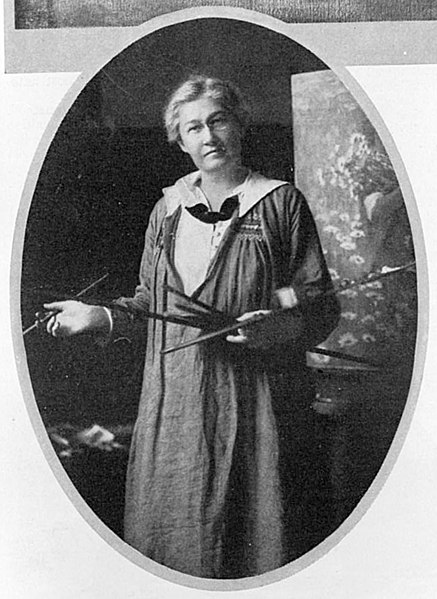Hello, again!
This week, I decided it was time to
finish my duckling picture
which I am painting on a recycled kitchen cabinet door
(I have had a couple of people give them to me when they came across used wooden ones that were unwanted).
I will be honest and admit that finishing this painting meant fixing that hand,
and painting hands is not something that I find to be easy.
I wish I had a bit more Jesse Wilcox Smith in me.
Jesse Wilcox Smith was an American illustrator born in Philadelphia in 1863.
Unlike many who pick up the pencil in childhood and sketch throughout youth, Jesse discovered in her early twenties that she enjoyed drawing and after studying under another great American illustrator, Howard Pyle, went on to illustrate for numerous magazines including over 200 covers for Good Housekeeping magazine.
Jesse was shy and lived with three (and then two when one left to be married), other young women artist. They had a 50' by 50' studio built over the top of a barn and lived in the nearby carriage house.
Despite the fact that she never married or had children, she is well-known for her images of mothers with children and was recruited by many to illustrate their children.
She used a variety of techniques: charcoal, oils, watercolors, varnishes.
You will likely recognize her work:
This is the image from A Child's Garden of Verses by Robert Louis Stevenson.
and this is the image she created for the book Heidi by Johanna Spyri.
(There are hundreds of other wonderful illustrations you can see by looking up Jesse Wilcox Smith.)
One thing Jesse is known for is her great ability to draw "hands."
I am not so skillful in the subject.
Skin is a colorful thing.
We may think of it as being generic in it's coloring,
but really, most skin colors have many colors in them.
I received this art catalog this week in the mail,
where I buy my copic markers and prismacolor pencils.
I noticed the painted woman's face on the front cover:
look at all the colors in it.
The catalog is in my hand right now, and it is actually more of a bluish tint, that greenish color around the nose, but there is green in there, too, yellow, pinks, browns, tans, whites, red, grays...
what color isn't in skin?
The way that light falls on skin can determine the colors in it.
Whether the hand is holding something can alter the coloring as well.
Notice the shading here?
The light is hitting the painted hand holding the duckling from the above left.
The light is hitting my hand directly straight down onto the side we see.
Can you see the difference in the coloring because of the shading?
To get warmed up with the paints, I decided to improve a few things in the duckling that I saw were wrong: the size of his eye, the coloring around his eye, and some of the softness in the shading of the feathers.
Once I had finished up and felt more prepared to paint the hand, I looked at it and tried to decipher the colors in it
(minus the marker and paint stains on the actual picture of my daughter's hand).
When I looked at the hand, I decided to start at the lightest sections and work down from there.
I put a fresh layer of paint on
and then worked down into the reddish-orange shaded area...
adding shading into the pointer finger as well.
I think part of the mark of being an artist is wearing some of the paint, don't you think?
My finger's always end up getting their fair share,
as using my finger to dab and mix in colors to blend seems to be a habit.
Of course, constantly looking back and forth to the picture and identifying features that need more shading or distinctive colors made me fall into working on the two fingers from the other hand,
and I just kept working on areas that looked like they weren't quite right yet.
The painted fingernail got a bit of shading.
I used just a touch of blue along the lower edge of the hand and blended it well with the black.
It seemed to soften the dark edge with a bit of blue in it.
I finished up by adding some crease lines along the lower finger and a few barely visible light lines of creasing where the wrist meets the arm.
I set the picture down and walked away for a few minutes.
I find it always helps to set it down when I think I am done and come back with fresh eyes.
I can pick out areas that need touching up
like lightening the lower line of the hand in places to make it look more gentle
and fixing duckling tail feathers that weren't quite long enough.
At this point, I decide that I am done.
The hand is not perfect but I am happy with it as it is far better than other hands I have done,
and I feel like if I play with the paints any more, I may ruin the contentment I have for it right now.
I finished a bit later with a slight background of the duck house wall.
It will brighten this wall in the bathroom until we take our things in to the fair in a couple of weeks.
What about you? Have you ever painted a hand
or had fun noticing the hues of the skin?
Take a chance to notice this week and challenge your artful endeavors.
Thanks again for stopping by!























































